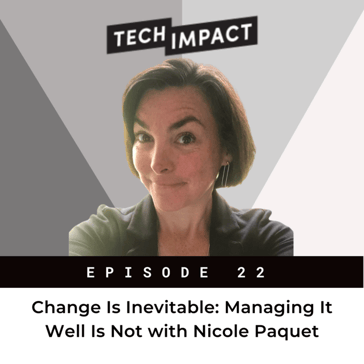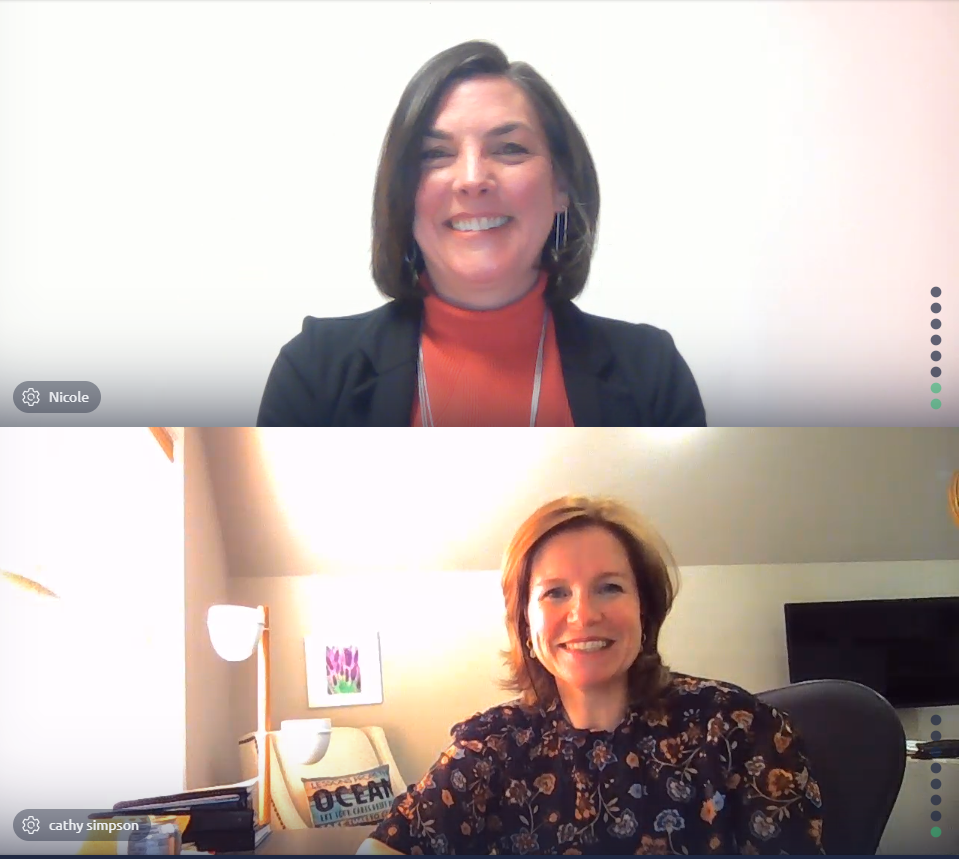EPISODE # 22 Change is Inevitable: Managing It Well Is Not
TechImpact

Change is inevitable; managing it well is not
“A change is as good as a rest," the adage says, but change management in business can feel more stressful than refreshing.
So, this week on episode 22 of the TechTalks Podcast, we're unpacking change management with one of those rare consultants who's worked in this area for all of her 20-plus-years' career. Nicole Paquet is a Senior Change Management consultant with Mariner, an IT and management consulting firm and long-time TechImpact member. She helps us understand what change management is, why it's essential, and how to do it better.
This show continues TechTalks’ exploration of digital transformation. Technology can enable growth, productivity, and competitiveness, but it needs to be accepted by those impacted by the change and align with the overall strategy. So, in this show, we're debunking myths and clarifying change management, which is often mentioned but not particularly well understood.

So, what IS change management, anyway?
"There are many different names," Nicole says, including “organization change management” and “organization change readiness.” While many people tend to think of change management in relation to IT and release management for technology projects, it can be applied to all kinds of projects, from a new computer system or office move to pivoting due to a global pandemic. There are many different kinds of clients, many kinds of changes.
Whatever the project, the change process and the principles are the same. It's about risk management, Nicole says. And that starts with a deep-dive organizational assessment.
"We tend to highlight a lot of risks at the beginning of a project, which sometimes feels to our project managers like we're slowing things down," Nicole says. "But it's really so we can put the right mitigation strategies in place to get those business results sooner and to a greater degree."
All together now!
The process is also front-end loaded with aligning the leadership team.
"Most leaders will tell us, 'Well, we're aligned,'" Nicole says. But with a bit of probing, it becomes clear that's not necessarily the case. And that's OK. The idea is to understand this at the outset and tackle it as a risk. Leaders have to go through a change process, too.
"Without that leader alignment, it's very difficult to support individuals through their discomfort,” Nicole says. "And that's OK because you can't have any change without discomfort, which is why change is so hard. So we need to be able to support our leaders through this process."
What change management is NOT.
Nicole sometimes sees companies make the mistake of thinking that change management is about making your staff feel good.
"It's not about being nice," she says. "It's about building capability, strategy and leadership."
And many organizations have a limited sense of the scope of change management, which goes beyond a new piece of software, say, to span organizational change, processes, and preparing people for the change. It isn't just a little communications or training. And it needs to be woven in from the start, well before the change takes place.
"Often, we get brought in too late, right before go-live," Nicole says.
Effective change management begins before and continues after the "flipping of the switch of the change," smoothing the way for the transition, getting people and processes in place to mitigate against the inevitable productivity dip, maximizing the investment.
"When you actually do the metrics after the fact, and you look at the performance, people don't always know how to use the system to its full capacity, so you don't get the benefits."
Partners in the project.
Nicole favours an integrated approach between project management and change management, always aligning change management to the business case, with strategies and approaches tailored to the organization's particular aims and needs.
"Every change is going to feel different, depending on the organization and the people and the culture,” she says. “And so that's really where the magic happens."
Increasingly, Nicole sees internal change management roles, a change she applauds and that she and her colleagues at Mariner support in their work.
"You want to leverage external consultants to some degree," she says. "But having your own internal capability is critically important to build that capacity over time and to build the resilience of your leaders."
Change management professionals show up in different places in an organization, from HR to a separate, standalone department or office. And there are many paths to change management, from business to psychology to communications. Along with an appreciation for process and at least a bit of data chops, a key trait is what Nicole calls "interpersonal flexibility" and a learning mindset because every project, every client is different.
"It never gets boring," she says, “that challenge of really supporting people through this process, and helping people realize that it's OK to feel uncomfortable.”
Nicole is a huge fan of process, "which a lot of people are surprised by," she says, "because they think I'm a people person. But it's really the process that I'm in love with."
Check out our entire conversation by clicking here to listen.
And here are some of the highlights from this episode:
>>[08:44]: Nicole unpacks some of the high-level confusion around change management.
>>[17:00]: Nicole talks about getting leaders to see change management as a business enabler.
>>[26:00]: We dive deep into alignment and why it's essential to change management.
>>[29:00]: Nicole unpacks the communications component.
>>[34:25]: A common question, answered: where is the best place for change management to live in an organization?
>>[42:05]: Nicole on the many paths into change management and critical skillsets for the job.
DON’T MISS AN EPISODE.
Do you subscribe to the Tech Talks With Cathy Simpson podcast? If not, please do. Every week, my guests and I will be covering lots of different topics around innovation, technology and the future. Click here to listen and subscribe in iTunes. You'll find us on Spotify, Apple Podcasts, Google Podcasts, PodLink and everywhere else you enjoy podcasts.
And sign up for our newsletter to never miss an update.
Visit Techimpact's website here


